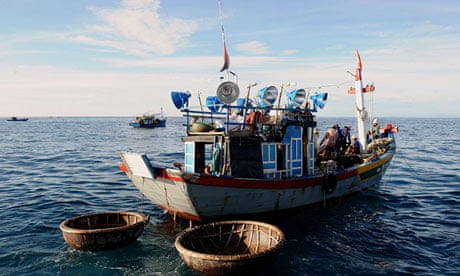The collapse of the Rana Plaza garment factory in Bangladesh underscored the importance of knowing the origins of consumer goods. Fortunately, tracing product points of origin is not a new area of work. A growing set of methods are available for tracking where goods come from, across a wide variety of consumer products.
Traceability is underway within sustainable forestry certification programmes (such as the Forest Stewardship Council), organic agriculture labelling, and in apparel (such as the Honest By label), and perhaps least well known, with seafood.
For companies, the lack of real-time fisheries data can result in ill-advised sourcing decisions. The reality is simple: without the timely data electronic traceability provides, all seafood retailers and restaurants are at risk of sourcing from collapsing fisheries which could have damaging effects on their brands.
During 2012, the Vietnam tuna fishery, formerly a longline fishery, changed to a handline fishery in under a year. This shift had dramatic ramifications as fishers' costs were greatly reduced, but so too was product quality. Overnight, the fishery was devalued, and access to necessary data was not available. Markets were lost and livelihoods adversely affected. Real-time data would have been invaluable to understanding the implications of this change.
In the seafood industry, there is an enormous opportunity to expand traceability– to identify and manage both supply chain risks as well as associated brand and reputational risks. One example is a scalable electronic system developed at Norpac Fisheries Export. Since 2002, Norpac has developed and refined a new system to allow tracking not only of the raw material, but the finished products – from location of catch through to the end user.
Within this traceability system, there is data capture that includes fishing area, vessel name, species, weight, grade, logistics chain, finished cut(s), yield, temperature, and more. Additional data on the length or colour can be included, indicating sex and maturity of the seafood. Fish cut into smaller pieces, such as fillets, can be "reassembled" electronically and traced to the vessel, or through to end users.
All this information is available in real time, and helps reduce waste, improve yield, enhance management, control quality, and empower employees. It allows managers to cost products, monitor value and inventory, as well as improve distribution and adjust production volumes.
The information could be accessed through electronic devices (desktop, laptop, tablet, smart phone) and offer fishers, scientists, marine resource managers, business managers and consumers an opportunity to access information previously unavailable.
In the best sense of the word, this traceability system is an example of disruptive innovation and part of the growing area of work that leverages IT for enabling sustainability. It can change the reality that fishery scientists often work with information that is dated, which is problematic as fishery conditions change rapidly, as do fishing methods and gear.
Given the serious implications of working with inadequate data, why don't more players in the seafood industry adopt this kind of traceability system? The barrier to adoption may be partly historical momentum (and inertia), or a lack of familiarity with opportunities to improve IT systems.
In the face of growing consumer interest in points of origin, as well as corporate risk associated with not knowing about goods sourcing locations, the time for adopting IT systems that allow for traceability is now.
It is not surprising that retailers—particularly grocers and restaurateurs—are recognising traceability as a key component of brand enhancement and risk mitigation, food safety and consumer confidence. Some leading companies have commitments to sustainable fisheries.
Ahold, which owns Stop&Shop and Giant among other grocery retail outlets and states that: "We realise the importance of working with and supporting fisheries and aquaculture operations that are taking the appropriate steps toward seafood sustainability."
Darden, which owns Red Lobster and a variety of other restaurants, says: "Seafood is the single largest item in Darden's overall 'food basket,' making up more than 30% of the total food we buy. We have a vested interest in ensuring that the supply of seafood on which we rely remains available, affordable and meets the quality and safety standards we expect."
McDonald's says: "Over the past 10 years, McDonald's commitment to sustainable sourcing has been best exemplified by our global Sustainable Fisheries programme. We have global purchasing standards and perform annual assessments of all suppliers by the Sustainable Fisheries Partnership (SFP). As a result, 100% of our fish worldwide currently comes from MSC-certified fisheries."
Traceability in seafood is gaining traction, as companies increasingly recognise the business opportunity. The ability to implement lasting and impactful change is at hand, the technology exists and is field tested.
The time has come to apply lessons learned, as in the Rana Plaza incident, to our seafood supply chain. We can reduce waste, improve viability, empower fishers, enhance management, and improve sustainability in wild capture fisheries. Companies, corporate foundations, and philanthropic foundations have the opportunity to quickly scale traceability throughout the private sector – and the time is now.
Sissel Waage is the director of biodiversity and ecosystems services at BSR. Thomas Kraft of Norpac Fisheries Export
This content is brought to you by Guardian Professional. Become GSB member to get more stories like this direct to your inbox

Comments (…)
Sign in or create your Guardian account to join the discussion